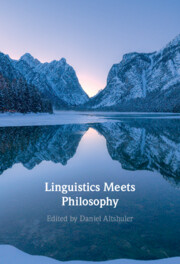Book contents
- Linguistics Meets Philosophy
- Linguistics Meets Philosophy
- Copyright page
- Contents
- Figures
- Tables
- Contributors
- Linguistics Meets Philosophy: A Historical Preface
- Introduction
- Part I Reporting and Ascribing
- Part II Describing and Referring
- Part III Narrating and Structuring
- 5 On the Role of Relations and Structure In Discourse Interpretation
- 6 Narrative and Point of View
- Part IV Locating and Inferring
- Part V Typologizing and Ontologizing
- Part VI Determining and Questioning
- Part VII Arguing and Rejecting
- Part VIII Implying and (Pre)supposing
- Index
- References
6 - Narrative and Point of View
from Part III - Narrating and Structuring
Published online by Cambridge University Press: 06 October 2022
- Linguistics Meets Philosophy
- Linguistics Meets Philosophy
- Copyright page
- Contents
- Figures
- Tables
- Contributors
- Linguistics Meets Philosophy: A Historical Preface
- Introduction
- Part I Reporting and Ascribing
- Part II Describing and Referring
- Part III Narrating and Structuring
- 5 On the Role of Relations and Structure In Discourse Interpretation
- 6 Narrative and Point of View
- Part IV Locating and Inferring
- Part V Typologizing and Ontologizing
- Part VI Determining and Questioning
- Part VII Arguing and Rejecting
- Part VIII Implying and (Pre)supposing
- Index
- References
Summary
We examine a previously undiscussed interaction between tense and predicates of personal taste (PPTs). While disagreements involving delicious or fun are generally considered faultless – they have no clear fact of the matter – we observe that, in joint oral narratives, this faultlessness varies with tense: if the narrative is told in the historical present, disagreements involving a PPT are not faultless. Drawing on narrative research in psychology and discourse analysis, we propose that this contrast reflects a pragmatic convention of the narrative genre that participants construct a consensus version of what happened from a unitary perspective. To link this pragmatics with the semantics, we adopt a bicontextual semantics, where the perspectival parameters for both PPTs and tense are located in a context of assessment (and not context of utterance). We show that when these contextual parameters are constrained by the unitary perspective of narratives, the present tense leads to nonfaultless disagreements, as its semantics tightly binds the temporal location of an event to the parameter relevant for appraisal. The past tense, by contrast, enables both faultless and nonfaultless disagreements. We derive this flexibility by revising the existing semantics for past tense, engendering a new perspective on crosslinguistic variation in tense usage.
Keywords
- Type
- Chapter
- Information
- Linguistics Meets Philosophy , pp. 176 - 214Publisher: Cambridge University PressPrint publication year: 2022
References
- 2
- Cited by

